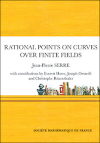- About MAA
- Membership
- MAA Publications
- Periodicals
- Blogs
- MAA Book Series
- MAA Press (an imprint of the AMS)
- MAA Notes
- MAA Reviews
- Mathematical Communication
- Information for Libraries
- Author Resources
- Advertise with MAA
- Meetings
- Competitions
- Programs
- Communities
- MAA Sections
- SIGMAA
- MAA Connect
- Students
- MAA Awards
- Awards Booklets
- Writing Awards
- Teaching Awards
- Service Awards
- Research Awards
- Lecture Awards
- Putnam Competition Individual and Team Winners
- D. E. Shaw Group AMC 8 Awards & Certificates
- Maryam Mirzakhani AMC 10 A Awards & Certificates
- Two Sigma AMC 10 B Awards & Certificates
- Jane Street AMC 12 A Awards & Certificates
- Akamai AMC 12 B Awards & Certificates
- High School Teachers
- News
You are here
Rational Points on Curves Over Finite Fields

Buy Now:
Publisher:
Société Mathématique de France
Publication Date:
2020
Number of Pages:
187
Format:
Paperback
Series:
Documenta Mathematiques
Price:
67.00
ISBN:
978-2-85629-923-4
Category:
Monograph
[Reviewed by , on ]
Felipe Zaldivar
09/20/2021
As with many of the wonderful books that Serre has written, this one started with the notes of a series of lectures that Serre gave, this time during the Fall Semester of 1985 at Harvard University. The handwritten notes taken by F. Q. Gouvêa in 1985 circulated in photocopies or scanned pdf files, frequently cited as the source were many “new” results were collected in Serre’s familiar lucid approach.
A collective effort brewed on the Arithmetic, Geometry, Cryptography and Coding Theory Conference at CIRM in Luminy, Marseille in 2017 transferred the original handwritten notes to LaTeX. After some editing by the organizers of this effort, and a full revision by J.-P. Serre, with emphasis on the mathematical content, we have now this original introduction to the classic topic of the number of points on curves over finite fields.
The renewed interest in this topic came from the theory of algebraic-geometry Goppa codes defined using the the rational points on curves over finite fields. A remarkable result by Tsfasman and Vlăduţ shows that if the number of rational points on the curve is large, the corresponding Goppa code has a better asymptotic rate between the block length and minimum Hamming distance of the code.
One of the tasks of Serre’s lectures was to give an improvement on the classical Hasse-Weil bound for the number of rational points on a smooth curve of genus g over a finite field F q with q elements. This was remarkably achieved by the new Serre and Oesterlé bound, and puts in perspective the original goals of the lectures and the book: First, to give sharp explicit bounds for the number of rational points on curves defined over finite fields. Second, to construct curves with many rational points. The original lectures and the book split naturally in two parts.
The first part, Chapters two to four, consider curves of small genus over an arbitrary finite field. Here, small genus means g = 1, 2, 3. Chapter two treats the refinements of the Weil bound and Chapters three and four consider the cases of curves of genus 2 and 3.
The second part of the book, Chapters five to seven, consider the case when the genus g is large with respect to the cardinality q of the finite field. Chapter five is devoted to the question of when the bound(s) on the number of rational points on a curve are attained, the problem of explicit formulas, and several class-field theory topics somehow related to these problems. Chapter six, on explicit formulas, was written by J. Oesterlé as his contribution to this book, giving an account of his treatment of this topic. Chapter seven is about the case when q = 2, using previous results to obtain upper bounds on the number of \( \mathbb{F}_{2} \)-rational points on curves of genus \( g \leq 120 \), with several explicit examples and tables describing the results.
Postfaces to Chapters 2, 4, 5 and 6, written by E. Howe and C. Ritzenthaler, discuss recent developments on these topics.
Felipe Zaldivar is Professor of Mathematics at the Universidad Autonoma Metropolitana-I, in Mexico City. His e-mail address is fz@xanum.uam.mx
See the publisher's website.
- Log in to post comments




